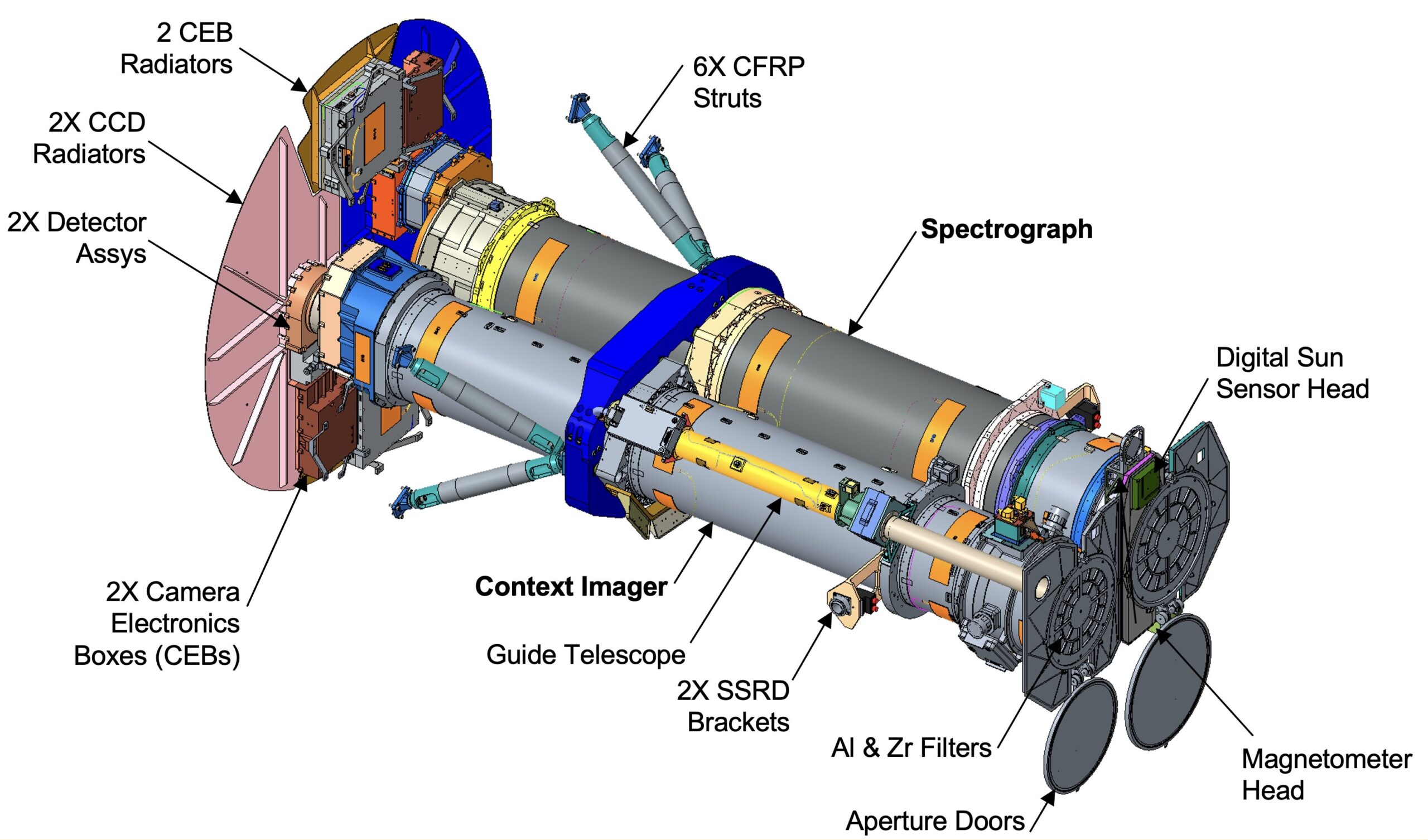Instruments
The MUSE payload consists of two instruments – the Spectrograph (SG) and the Context Imager (CI) – that both observe the Sun in extreme-ultraviolet (EUV) light, emission that is primarily emitted in the solar corona; an Image Stabilization System (ISS), and the Active Sun Irradiance Observer (ASIO) student collaboration:
Multi-slit Spectrograph (SG)
An EUV integral field spectrograph with an innovative 35-slit design for high-throughput spectroscopy in three EUV passbands (108Å, 171Å and 284Å). These passbands are dominated by strong spectral lines that are emitted by highly ionized iron (Fe), which under coronal conditions forms at temperatures of 0.8 million K (Fe IX 171Å), 2.5 MK (Fe XV 284Å), and 10 MK (Fe XIX/Fe XXI 108Å).The Spectrograph combines a 25 cm Newtonian telescope with a stigmatic, multi-slit EUV spectrograph to provide spectroscopy in three wavelength bands with spatial coverage of a full active region in each exposure. At the focal plane, the 35-slit mask replaces the usual single-slit, and narrowband coatings on the primary and grating isolate the three wavelength regions to avoid overlap of unwanted spectral lines. The primary mirror and grating are coated in three matching sectors with high-efficiency coatings. The aberration-correcting, holographic, blazed grating is on a concave substrate, to disperse and re-image the slit mask directly onto three CCDs, one for each passband. Light is simultaneously collected along 35 slits which are 0.4 arcsec wide, 170 arcsec long and separated by 4.45 arcseconds. By scanning the small distance between neighboring slits, spectroscopic raster scans can be obtained over a region of 156 arcsec x 170 arcsec at a cadence of 8s (for flares) to 20-60s (active regions and quiet Sun) and with a spatial resolution of 0.5 arcsec. The design of the spectrograph is based on heritage from previous instruments or missions that Lockheed Martin Solar & Astrophysics Laboratory built and operates for NASA, such as IRIS (Interface Region Imaging Spectrograph, iris.lmsal.com), SDO/AIA-HMI (aia.lmsal.com), and Hinode/FPP (sot.lmsal.com).
Context Imager (CI)
A high-resolution EUV imager that obtains even higher resolution (0.4 arcsec) images in two broad passbands centered around 195Å and 304Å. These passbands are dominated by Fe XII (sensitive to plasma around 1.5 MK) and He II (0.1 MK, i.e., the cooler transition region). The CI thus provides highly complementary data to the SG, expanding the temperature range and the field-of-view (to 580 arcsec x 290 arcsec). The design of the context imager is based on the SDO/AIA instrument, which includes 4 EUV telescopes and has been in operation since 2010, as well as the successful Hi-C sounding rocket, which was the first instrument to provide ~0.3 arcsec resolution images of the corona, and has had several successful flights.
Image Stabilization System (ISS)
Both the spectrograph and imager benefit from an image stabilization system that is derived from IRIS, using a guide telescope. The ISS enables the excellent pointing stability that is required for the very high resolution observations.
Active Sun Irradiance Observer (ASIO)
MUSE also contains a student collaboration project called the Active Sun Irradiance Observer (ASIO), which will obtain soft X-ray light curves of the Sun at a cadence 3 orders of magnitude faster than the current GOES X-ray sensors. Students will lead the development and operation of ASIO.
This movie shows the intensity and Doppler shift of the Fe IX 171Å spectral line from a numerical simulation of a coronal mass ejection (CME) on the left. The right column shows how the 35-slit design of the MUSE spectrograph for the first time can capture the very fast evolution of this eruption using a spectrograph.

